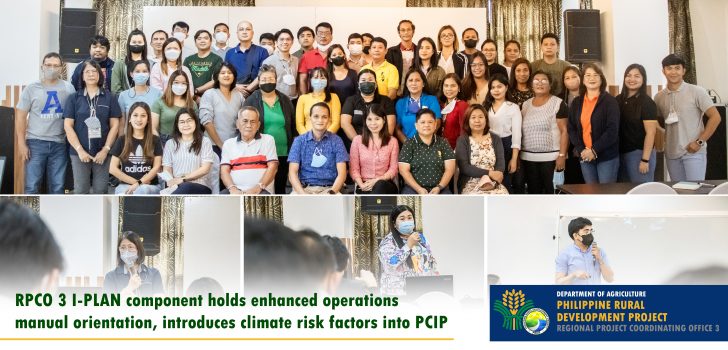
RPCO 3 I-PLAN component holds enhanced operations manual orientation, introduces climate risk factors into PCIP
As one of the initiatives of the DA-PRDP to roll out the I-PLAN Enhanced Operations Manual (e-OM), the Regional Project Coordinating Office 3 (RPCO 3) with the North Luzon Cluster Project Support Office (PSO) I-PLAN counterparts convened an orientation on the e-OM and capacity development on the climate risk and resiliency integration to the Provincial Commodity Investment Plan (PCIP). This was participated by the seven (7) Provincial Core Planning Teams (PCPTs) of Central Luzon at the Sunshine Grandeur Hotel, Angeles City on June 27-30, 2022.
The e-OM on Planning for Agriculture and Fisheries Investment at the Local, Regional and National Levels (I-PLAN) of the DA-PRDP is meant to serve as an updated guide for investment planners – those responsible for preparing investments programs – on the implementation of I-PLAN activities, from the prioritization of national, regional, and provincial commodities, through the conduct of climate-resilient value chain and such other analyses of priority commodities, and eventually to the preparation and Commodities Investment Plans (CIP) at the provincial level.
During the orientation, the RPCO 3 I-PLAN component staff presented the investment planning tools and the step-by-step process of the Commodity Systems Investment Planning (CSIP) from the enhanced PCIP preparation process, followed by the Regional Perspective in planning, and to how the national level highlights the use of the CSIP outputs in enhancing the national plans. Moreover, the organizational and resource requirements to implement the CSIP process, activities enhancing support to the CSIP process, and the efforts to integrate and mainstream the CSIP process in the DA were also discussed.
In line with the DA’s efforts in developing Agriculture Sector by providing a climate resilient projects and modernized operations through digitalization, DA-Regional Field Office III – Adaptation and Mitigation Initiative in Agriculture (AMIA) focal person Eduviges Pelayo revealed the process and importance of Climate Risk Vulnerability Assessment (CRVA) and PSO, Geographic Information System (GIS) Officer Romille David capacitated the participants in navigating the Planner’s Portal website. The CRVA and Planner’s Portal are among the new tools integrated on the eOM.
To further grip and apply the discussions of the activity, a workshop was conducted led by PSO, I-PLAN Planning Officer Ms. Janelyn Golingo where all improved templates in preparing Provincial Commodity Investment Plan were properly demonstrated.
The said activity featured seven (7) science-based tools (2 enhanced, 2 retained and 3 new tools) that will be widely used in enhancing the National Agricultural and Fishery Modernization and Industrialization Plan (NAFMIP) through the preparation and updating of CIPs, serving as its local foundation. It was also joined by the newly included member of the PCPT, the Provincial Disaster Risk Reduction Management Office (PDRRMO), expected to provide necessary insights to the investment planners regarding climate risk factors. (By: Ram Bautista, RPCO3 InfoACE with inputs from Planning Officers Ma. Lourdes Maglanque and Jerome Manuyag)
